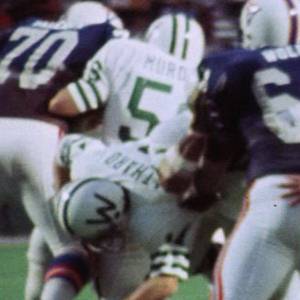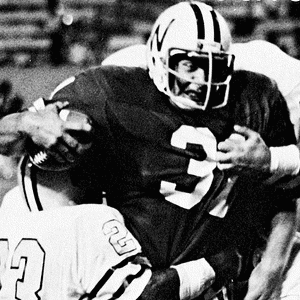

Chicago
WFL
Winds
- 1975
Pullano brought in Babe Parilli as General Manager and Head Coach. Having
guided the New York Stars/Charlotte Hornets in 1974, Pullano viewed their
overall won-loss record and the fact that they were rated second in rushing
offense and first in pass defense in the league, and believed he could field a
winning team. Parilli’s staff included Stew Barber, the former Buffalo Bills’
All Star lineman who had been his offensive line coach through the turmoil of
1974. Defensive line coach Dave Brazil had been the Detroit Wheels’ defensive
coordinator until their untimely demise, and Joe Popp, who had coached at a
number of Atlantic Coast Conference schools was brought in to tutor a variety of
positions on the offense. Demonstrating the type of loyalty he had learned under
the tutelage of Paul “Bear” Bryant, Parilli brought Charlotte and former Jets
equipment man Mike “Tiger” Ferraro with him from the Hornets. The details remain
murky and not well documented, at least not more than thirty years after the
events but Parilli and his staff never had the opportunity to guide the Winds.
As this original staff went through training camp and assembled a team, they
could not have predicted that after pre-season games against the Jacksonville
Express and Parilli’s former team in Charlotte, the Winds would be greeting a
new General Manager and a brand new head coach, one with a Chicago lineage. As a
cost-cutting measure, Pullano fired Parilli five days before the start of the
Winds first regular season game. In short order, Memphis Southmen GM Leo Cahill,
a long-time employee of Southmen owner John Bassett was no longer their General
Manager but now the new GM of the Winds, and on July 28th, Cahill
hired Abe Gibron as his new head coach. Gibron was a Chicago staple
having spent twelve years with the Bears as a player, assistant coach, and head
coach. A huge man in girth, he had played at approximately 250 pounds at a
height of 5’11” during a time when most offensive and defensive linemen were
little more than 210. As his playing and then coaching career progressed so did
his bodyweight and sportswriters often amused themselves by regularly trying to
guess his weight that easily topped the three hundred mark, most carried in his
ample middle. Abe was no circus fat man however, but a shrewd, experienced, and
highly respected football man, an original from the All American Football
Conference and a long tenure under the legendary Paul Brown where for seven
years he was a key cog in the Browns’ championship machine. He was named to four
Pro Bowls and the 1952 All Pro team and was best known for his quick and agile
charge off the ball. After a season and a half with the Eagles, Abe spent 1958
and 1959 playing for the Monsters Of The Midway and endeared himself to Chicago
fans. He also endeared himself to the media with his wit and ability to put
inhibition aside when discussing the state of the Chicago Bears or anything
else. A typical Gibron quote concerned Bears scatter armed quarterback Bobby
Douglas, a wonderful physical specimen whose productivity never quite matched
the expectations for him. In Abe’s words, “He could throw a football through a
brick wall, if only he could hit a brick wall.” Abe was always considered
something of a Chicago hometown boy as he grew up in Michigan City, Indiana,
over the state line but like Gary, Indiana, considered by many as a Chicago
annex. Abe attended Valparaiso and then Purdue at a time when Purdue was
considered to be the pre-ordained destination of the best of the Chicago area
players. He was a Redskins assistant coach from 1960 through 1964 under their
head coach Bill McPeak and returned to the Bears in the same capacity in 1965,
working first under George Halas and then Jim Dooley until 1971. Gibron was then
named the Chicago Bears Head Coach from 1972 through ’74. The Winds were so sure
that Abe would be an attraction by himself, such was his popularity in and
around the Chicago area that they dedicated their inaugural home game against
the Portland Thunder on August 16th as “Welcome Back Abe Night.” The
fans also had to welcome a new coaching staff. Gibron brought his former
Washington Redskins boss Bill McPeak in with him. McPeak had a reputation as an
innovator although his stint with the Redskins from 1961-1965 was not
successful. Joe Popp stayed on board as the holdover from Parilli’s staff but
the team went into their opener with a three man staff of Gibron, McPeak, and
Popp as Stew Barber, Dave Brazil, and Burley Crowe left with Parilli. Equipment
man Ferraro opted to finish the season with the Winds, not realizing how short
that stay would be.
The Winds seemed to have
some decent offensive weapons that were fortified on June 18, 1975 when Pullano
personally signed Mark Kellar, Pete Beathard, and John Gilliam. Kellar was an
area star and very popular. He attended high school in Chicago and then led the
NCAA in rushing at Northern Illinois University. He had true NFL credentials but
had thrown in with the WFL in 1974, leading the league in rushing until breaking
his foot in the September 11, 1974 game against the Sun. Fire quarterback Virgil
Carter was no longer in Chicago but instead residing in San Diego with the
Chargers for 1975. As he wouldn’t return to Chicago again until 1976, completing
his pro career with the Bears, quarterback was left to Pete Beathard, the former
USC star who had kicked around the NFL since 1964. He was a part time starter
behind an oft-injured Len Dawson with the Chiefs and then led the Oilers from
1967-1969. With the Cardinals for the 1971 and ‘72 seasons, he had teamed with
John Gilliam but was with the Rams in 1973 before finishing his NFL career with
the Chiefs, appearing in nine games to close out 1974. He was cut in time to
join the Portland Storm for the remainder of their WFL season. Gilliam had come
out of South Carolina State in 1967 as the Saints second round draft choice and
he was an electrifying kickoff returner and quality receiver. Two years with the
Saints, three with the Cardinals, and another three with the Vikings where he
believed he was worth more money than he was being paid, led him to the Winds.
As a bonus, they wound up signing Gary Danielson late and he contributed nine
completions in fifteen attempts as Beathard’s backup. Margene Adkins was
expected to complement Gilliam at the other flank. Adkins had gone from Trinity
Valley CC in Texas to Ottawa in the CFL and after three outstanding seasons
there he was the Cowboys second round choice in 1970. He backed up Bob Hayes and
was an effective kick return man before being traded to the Saints and then led
the NFL in kickoff returns in 1972. He played with the Jets in 1973 but missed
1974 due to injury. Eagle and Chicago Fire retread Cyril Pinder was to team with
Kellar in the backfield but the offensive line was not going to be a strong
point. One of the offensive line regulars however was Mike Wilson. He had first
gained attention when playing for Dayton, starting at both defensive tackle and
fullback, a rather unusual combination, even in the two-way-player days. Wilson
however, at 6’3” and 250 pounds was a man playing with boys and John McVay,
Dayton’s Head Coach during Wilson’s college career used him where needed. He
started his college career as an offensive tackle and when the Bengals drafted
him almost as an afterthought in the fourteenth round in 1969 they didn’t
realize that he would develop into an offensive lineman who would appear in
every game by the time the 1970 season had ended. Injured in 1971 he was shipped
to the Bills and languished until finding a starting role with the Detroit
Wheels in ’74. After the Winds folded, he was chosen in the so-called
“improvement draft” by the Philadelphia Bell but opted to head back to the NFL
and finished the 1975 season with the Chiefs. Wilson was the prototype of the
WFL player, a guy who was multi-talented and could play a number of positions
well enough to earn a living doing it but often not quite at the NFL level.
Defensively, the WFL fans in
Chicago knew only disaster from the year before. With former Fire defensemen
Chuck Bailey and Ken Sanduk at tackles, Mick Heinrich at end, Chuck Kogut at
linebacker, Hal Phillips at the corner, and Ralph “Sticks” Anderson and Harry
Howard at the safety positions, the Winds managed to put a defense on the field
that was little improved from the worst unit of 1974. Ralph “Sticks” Anderson at
least was an excellent athlete who had the pedigree of having played for the
Steelers and who had been a teammate of Duane Thomas, “Mercury” Morris, and
Rocky Thompson on some of Joe Kerbel’s best teams at West Texas State. Even
coming out of camp, this unit was not going to strike fear into the hearts of
their opponents. The defensive performance exceeded expectations in the opener,
a tough 10-0 loss to the Birmingham Vulcans. Against Shreveport, what would
become standard operating procedure kicked in. That 38-18 loss was followed by
their only win of the season, an overtime barnburner with Portland that the
Winds pulled out 25-18. Two more losses followed with a per game yield of thirty
points and Pullano’s other investors wanted out. They managed to withdraw escrow
money that had been placed in what was supposed to be a secure account and the
Winds, five games and 1-4 into the season, were gone. Their only home game drew
less than 3500 fans and after the $175,000.00 deposit was withdrawn from the
league office, the WFL, on September 2nd, revoked the franchise and
allowed the players to be dispersed. Gilliam, also chosen by the Bell to help
“improve” their team, realized that money wasn’t there to pay his salary and
immediately re-signed with the Vikings, no doubt grateful for the early July
start to the WFL season as this allowed him to appear in all of Minnesota’s
games for the 1975 season. Danielson had to wait until 1976 to hook on with the
Lions and begin what turned out to be an eleven-year NFL career. The Chicago Winds instead of
being one of the model franchises of the New League WFL was the first in this
house of cards to collapse. The other ten franchises moved forward but the
writing was on the wall. It also appeared as if someone had done some writing on
the Winds helmets! A nondescript green “W” did not reflect the more
imaginative “W” which was overlaid upon a green football shaped design that the
Winds had on their media guide and other official league communications and that
eventually was used on the sides of the game helmet. While plain and simple is
most often nice when it comes to football helmets, the Winds “W” appeared as if
the Chicago brain trust did not put a great deal of thought into the helmet
logo. The two 1" green off center stripes helped to make the helmet more acceptable but
this was not one of the better WFL offerings. Their white jersey with two green
sleeve stripes or the green jersey with black outline on white sleeve stripes
was a good look but the Winds very much played poorly and looked only one or two
notches above that level in the helmet that was worn against the Hornets in
their July 19th pre-season game.

